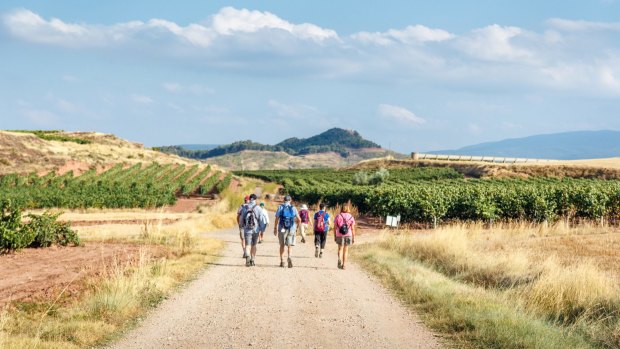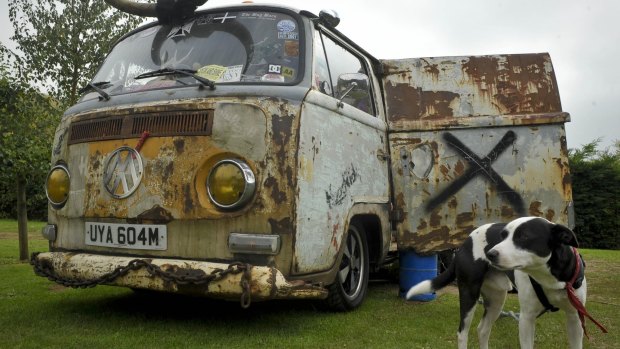This was published 6 years ago
The way we were: How the great Australian Europe trek has changed

Pilgrims walk the Camino de Santiago along wheat fields and vineyards in La Rioja, Spain.Credit: Shutterstock
Every year they would gather, like pilgrims arriving in a holy land. The vans would start rolling in around mid-September, all in various states of disrepair, old clunkers decked out with camping gear and draped in Australian flags. They would pull into the Thalkirchen campsite, just outside Munich, and disgorge their ragtag crews of travellers and drinkers.
It was time for Oktoberfest, a centuries-old celebration of Bavarian culture for locals, and the traditional beer-soaked culmination of a summer's worth of European travel for the Aussies and Kiwis who'd been seeing the continent in the customary way, in the back of a van, through the dirty windows of a clapped-out VW. The next few weeks would be a blur of booze and brief snatches of sleep, a riot of bratwurst and regret, as Oktoberfest was observed and enjoyed. Then, the bags would be packed up, the vans would be sold, and everyone would go back to their old lives at home.
This used to be the journey. This was the classic. A road trip around Western Europe was an Australian rite of passage, the obvious choice for anyone keen to have an overseas adventure. This was what we did. And in some cases, it's what we still do.

Classic: Touring Europe in a clapped-out VW van.Credit: PA Images / Alamy Stock Photo
However, journeys have changed. Markedly. They've changed since those first Aussie backpackers began arriving in Munich every September, and they've changed even more in the last decade. The destinations we visit have changed: it's not just Western Europe that attracts the travellers. And the styles, too, have evolved, as the mini-vans and the large touring coaches have been shunned in favour of transport options that more closely reflect the areas of the world in which we appear.
"These days, travel is about the experience as much as the destination," says James Thornton, chief executive of Intrepid Travel. Australians are no longer looking to just tick boxes, he says, to see the Colosseum and the Eiffel Tower and to "do" Oktoberfest, but rather they're looking for something more authentic, something local and unique.
"Sitting on a big coach isn't necessarily the way people want to see a country now," Thornton says. "They want to get out and try the local food, interact in the markets, try to live like a local. So [on our tours now] we use trains, local buses, jumping on a bike, or even just walking through a village."
There's no such thing, any more, as a "standard" itinerary. Even in the destinations that have really opened up in the last decade, the likes of China and Japan, and South America, travellers aren't likely to tread the beaten path. Journeys through these countries have to take in more than the obvious tourists sites such as the Great Wall or Machu Picchu. Those places are still extremely popular, but they have to form part of a wider experience.
"There's such a wide range of weird and wonderful requests from travellers now," says Andrew Mulholland, the managing director of China travel specialists Wendy Wu Tours. "With the advent of Google and the Discovery Channel, people are well educated. It's not just the "golden triangle" in China any more; for example, not just Beijing, Xian and Shanghai. People are looking beyond that, and it's making us stay on our toes.
"If you look at the modern Australian traveller, a lot of us are into a little bit of activity when we travel, mountain-biking, hiking, mixing five-star accommodation with the contrast of local accommodation in rustic villages. We're now putting together trips under the banner of 'discovery', and that's where our largest growth is: immersive, soft-adventure travel."
Perhaps the biggest change to the way people journey now is the search for and the appreciation of "authenticity". Those vanloads of travellers pouring into the campsite in Munich back in the '80s and '90s were never particularly concerned with seeing the world through local eyes – they just wanted to have fun. Same with the larger European coach tours of the 2000s. And there's nothing wrong with that.
Now, however, priorities for travellers have shifted. They want to move through the world in the same way as the locals in their destination would. They want a slice of typical life. They don't so much want to see things as experience them.
"There's been quite a considerable change in the way people are travelling," says Greg Carter, the managing director of Latin American travel specialists Chimu Adventures. "When you see mainstream operators starting to offer different forms of transport, more locally orientated sustainable type experiences, it says a lot. The momentum is really shifting."
That can be seen, Greg says, across a range of destinations. "People are looking for more of an experiential type trip. Like in Cuba, travellers are doing homestays instead of staying in hotels, they're doing cooking classes, eating meals in local homes. That type of thing is huge. You get a lot more clients asking for that."
The old overland tour buses that only 10 years ago were so popular in South America, Greg says, are now rusting away in yards somewhere. That's not the way travellers want to see the world.
"Escorted tours are still popular," he says, "they're still growing. But it's the way they're done that's changing. In South America there's been a decline in the overland tours. A lot of people are shifting to public transport, or to that small-group set-up."
Indeed, there's been no let-up in the demand for escorted tours – Intrepid Travel's total sales are up 19 per cent on last year alone. The difference in the last decade has been in the way they're conducted. It's not large groups being dragged around the standard guidebook sights any more, but rather small parties of travellers who choose to narrow their focus, who follow their own passions rather than sign up for the regular itinerary.
"People are combining their hobbies and their personal interests with their travel plans," says James Thornton. "We've seen at Intrepid, people want to cycle, or they're interested in food – it's not so much the level of travel, three-star or four-star, that people are interested in, but more combining your passion or your hobby with your experiences on the ground."
And one of those passions that has developed over the last 10 years is for grand adventures, for the sort of trips that might once have seemed a little too difficult or time-consuming. Bucket lists these days don't just include single sights such as Uluru or the Great Pyramid, but rather entire journeys, the likes of the Camino de Santiago in Spain, or the Kumano Kodo hike in Japan, or even train trips such as the Trans-Mongolian.
This is all part of the trend towards experiential travel, towards immersing yourself in a culture rather than simply drifting through it. The Camino de Santiago is a pilgrimage across Spain that's done on foot, a journey that takes travellers several weeks or months to complete. In 2006, just over 100,000 people walked the Camino. Last year that number had almost tripled, to some 280,000. It's a similar story on the Kumano Kodo, a pilgrimage through Japan's Kii Peninsula, as word gets out about this amazing experience.
"I think people are increasingly becoming better educated, through the internet and social media," says Intrepid's Thornton, "so they're now looking for more tailored and unique experiences. These days it's not so much about having the biggest house or the best car, but having the best experience that you can then share with friends and family at home."
That increase in knowledge has led to a similar increase in demand from travellers for bespoke tour options, with companies such as Wendy Wu Tours now providing customised itineraries to formerly untouched parts of China and south-east Asia. There's also plenty of interest in independent travel, of taking risks and getting out to the see the world on your own. Those clapped-out old vans are still making their way around Western Europe, but travellers are increasingly keen to see the US, southern Africa, and even South America in a similarly independent style.
Of course, there will always be a market for escorted tours and small-group cruises, particularly as they morph to reflect the changing desires of the modern traveller.
"It's just easy," says Andrew Mulholland from Wendy Wu Tours. "For people who've spent their whole lives working, this is a retirement treat. Or this is your one holiday of the year and you want the hassle taken out of it. And travellers rely on operators like us to keep it exciting. The touring we were doing five years ago is no longer relevant, it's evolved. We're always looking for new types of experiences."
Sign up for the Traveller newsletter
The latest travel news, tips and inspiration delivered to your inbox. Sign up now.